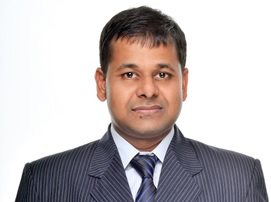Steering a path to the post-pandemic future is challenging. Looking ahead to 2021, key planning assumptions are changing fast. What’s next for the manufacturing business world? International Metalworking News for Asia asked key thinkers to weigh in on what the future holds, the opportunities, and trends that fit into the “new normal.”
Mr. Rajdave Sidhu
Regional Product Sales Manager, X-ray Southeast Asia, ZEISS

In terms of future approach in technology, ZEISS is positioned to support some of the market demands focused on quality inspection solutions. At the moment, parts that are being manufactured are getting smaller, and the time required for these parts to be inspected are much faster. “Things getting smaller, parts getting inspected faster,” these are the challenges in production now. Everything is about time and money. For us, we started with CMMs (coordinate measuring machines) and that is for more physical system. It needs to touch the part and then get some information about the quality.
For example, a fuel injector has parts that are smaller than 0.1mm, so that is extremely small. There’s no physical probes that can actually measure something so tiny. This is where companies now, especially quality inspection companies like us, explore and experiment with new technologies, such as 3D scanners and also x-ray solutions. With x-ray solutions, if you will get our system with higher resolution this kind of system like this fuel injector that I’m talking about can be expected very quickly and with the best resolution. When it comes to speed, our system like the VoluMax CT systems could scan parts less than a minute. Imagine an engine cylinder head in your car being scanned in less than a minute to check the qualities. That’s extremely fast. This is where the direction of the market is now. In South East Asia or APAC, I think we should look into how we can continue to develop better.
When it comes to upgrading, we have to see how upgrading can produce better quality in the products. For instance, investing in a quality system. The system must be able to ensure that rejects are low and the parts supplied to customers are good. In the long run this could actually yield growth and could in fact provide subsequent new projects. Because there are times when companies struggle to get projects because they don’t have the right tools to do the inspection. This is such a waste because in South East Asia especially, we have a very good workforce, hardworking and intelligent people. And often times I see that this kind of limitation is what deters a company from prospering.
Apart from the machine itself, software is another thing that we should also consider. Nowadays, we hear a lot from Google for example with machine learning. They pioneered this and now a lot of big companies in America and Europe, have machine based learning software that help make things much quicker and much more perfect. Having state-of-art technology alone is not enough, consistency is another matter which needs to be good. Image segmentation is currently one of the biggest challenges in microscopy and the foundation for all subsequent image analysis steps. ZEN Intellesis uses established machine-learning techniques powered by Python, such as pixel classification and deep learning to easily create robust and reproducible segmentation results, even for non-experts. With machine leaning software such defects are learned and if not detected for the first time.
For Asian companies to curve a niche in the global market, it is a must to be technologically advanced. We need to do this because if we don’t, we might not be relevant anymore 5-10 years from now. With the right investment in systems, there is a huge possibility that you can go up the supply chain.
Mr. Owen Wu
Sales Manager, TM Techman Robot Inc.

Under the serious impact caused by COVID-19, decision makers are always stuck when it comes to budget/return on investment (ROI) and other complicated levels of application. And so, collaborative robot is a great incentive for SME (small to medium size enterprise). To invest more resources on automated production, enterprises must be willing to complete the automated level of assembly line through collaboration with operator and robot. This eliminates the gap and brings the images up to a user friendly tool instead of individual device.
Let me emphasise the concept on multiple dimensions, collaborative robot is necessary on the implementation of automated production in Vietnam, Thailand, Malaysia and Taiwan. The demand for robots are amazing, more than our expectation. We found the reason is due to labour shortage issue becoming more serious. Another advantage of Techman robot is flexibility on assembly line, you could do the application as load/unload and machine tending with embedded vision coordination and TM trademark.
The demand for robots is shooting up, especially with 20-30% YOY growth for collaborative robot and the most contribution is from Asia market. Techman robot not only provides hardware robot product but also the software package as monitoring software, TM manager, which is able to collect robot parameter like temperature, electricity, real time and running project detail. Advance function is to connect to equipment and control by dashboard and present the information as yield rate and bottle-neck date from assembly line. That is fantastic. One AOI function is advanced. Integrated with EIH and ETH 3D camera, we are able to do 3D bin picking function with geometry/point cloud and objective 3D file imported, collision check function is also available. Furthermore, Techman worked with Adventech server for AI+ detect inspection, with external camera on working station, TM robot continues to take pictures and upload to server for sample build-up, then downloaded it into TM flow for sample verification. =This is up-to-date technology is a trend for automated manufacturers.
Finally, Techman is expected to provide simple solution to every single customer as easy as using a smart phone. With few steps to go, you will get automation in assembly line and this is what we emphasize and what we expected to hear from local customers.
Mr. Nihal Ranjan
Sr. Lead Consultant – Industry 4.0, Robert Bosch Vietnam Company Limited

Presently the world is gripped with Covid 19. Sooner or later this pandemic will flatten and businesses will start working on normalisation of work and manufacturing. A majority or all of large businesses will survive but we will also see survival fight for small and medium businesses. The world will not be the same and this is the right time to think how businesses can be more agile and responsive to future challenges post Covid 19 world. Below are few of my thoughts that manufacturing businesses can consider for future:
1) Strategy for disruption and manufacturing continuity: Manufacturing companies need to consider disruptions due to force majeure, such as natural calamity, pandemic, war while creating business continuity plans. The way some of big manufacturer consider warranty and recall costs as part of pricing strategy, same way force majeure fund for 3- 12 month of disruption need to be considered in pricing strategy. Manufacturing location strategy should consider disruption due to non-availability of supply chain and can consider multi geographical production using single or multiple supplier option. In the very near term manufacturing organisations need to create quickly a utilisation plan for utilising benefits being given by governments. For certain manufacturing operations it can be a benefit due to increased demand and for some it can be further optimisation or expansion of supply chain. Independent business sector with no/minimal interlinkage should become a criterion for business growth and sustainability.
2) Supply Chain and logistics: We have always been told inventory is one of biggest waste however organisations should start looking at what is right inventory level for raw material and finished good while factoring forced disruptions. The forecasting mechanism need to consider force disruptions while creating production plan and schedules. The real time visibility need to expand from four walls of factories to supplier bases and point of sales location. This basically means either factories need to provide end to end management software for real time visibilities or opt for seamless integrations. On logistic front companies need to develop and validate different fulfilment channels along with clear cost metrics. The essential or daily need manufacturing companies can work on creating a transparent logistic cost model so that during time of crisis costs can be passed or absorbed without much deliberations and future impact. For order fulfilment the businesses that don’t use ecommerce channels they need to create one and probably to reduce cost of such channels companies need to collaborate rather than creating their own.
3) Manufacturing: The manufacturing factories around globe are designed for producing same family of products. We call it model mix production facilities. In post Covid 19 world, we can start thinking one step ahead and designing facilities for producing products from two or more lightly similar or totally different product family. As of now what I can think of is automotive factories can think of producing medical devices factory. Electronic factories can think of producing essential medical electronic factories, textile and related factories can think of producing personal protective equipment.
Manufacturing process designs need to consider merging and demerging of processes for quick capacity and manpower utilisation changes, while keeping product family in consideration. As part of manufacturing process, design automation can take priority over return on investment in short period. Process engineers need to validate and keep ready process design for different capacity utilisation. I suggest to use an increment of 5-10% for capacity utilisation process design. The business cases for investment can consider 2-4 months of revenue loss as basis for return on investment while deciding on investment.
Companies and government can consider essential commodity/supplies manufacturing using different factory as part of investment approval. The ready/non-patented availability of blue prints of manufacturing for essential supplies for human life can be basis for incentives by governments.
Emergency response preparedness audit/check by manufacturing facilities must become an industry norm. Factories need to expedite readiness and utilisation of predictive analytics using machine learning and artificial intelligence for use cases such as demand forecasting, scheduling, maintenance etc. Digital transformation/ Utilisation of Industry 4.0 solutions for manufacturing execution and optimisation should become a norm and industry bodies should lobby for government support/incentive in post Covid-19 era. Digital economy consideration by governments must consider manufacturing transformation and readiness for unforeseen conditions.
The human resource department of manufacturing organisations should create/adapt continuity plan using remote workers at least for non-essential workloads. Multi skilling and crisis readiness should become human resource important KPIs.
Mr. Daniel Pham
Operational Director, Vietnam Outsourcing Pte Ltd (VNO)

We play our part in a slice of the global supply chain of metal component. So we can see very obviously impact, we foresee a drop in demand for the second half of 2020 and probably 2021 as well, since most of our customer base are in the US and EU – where the pandemic hit hard. We also see a significant drop in traffic from our marketing media during April/May, when most major city were on lockdown, people working from home, company temporary close and etc. By the end of May things start to pick up. We even signed some two years contracts with our main customers. So it’s not too bad for industrial manufacturing compared to some other industries.
On the other hand, certain thing that would never have happen without the pandemic happened. Most of our clients would require full audit of factory before placing an order. Now people can’t travel for business, so everything was done online. In just a few months, we have won some new contract during this period actually and some of them are very big.
So in a way, this can be seen as an opportunity for those who are really good/remarkable and can gain trust from the international clients without physical meeting. In fact you can do it very efficiently. At the end of the day, during a pandemic, you will have to rely on trust and very importantly optimism. As mentioned above, this difficult situation can also be an opportunity for those who are truly remarkable.
Well in business or in life, setbacks will always be there, with or without the pandemic. Those who can bounce back faster after setbacks, those who can see that obstacle is the way are one that will be successful. And the foundation of that journey to success is a strong sense of self belief, sheer desire to get ahead. It’s a desire to constantly learning, improving and implementing new way to work, to adapt and triumph.

 iConnectHub
iConnectHub
 Login/Register
Login/Register Supplier Login
Supplier Login



























